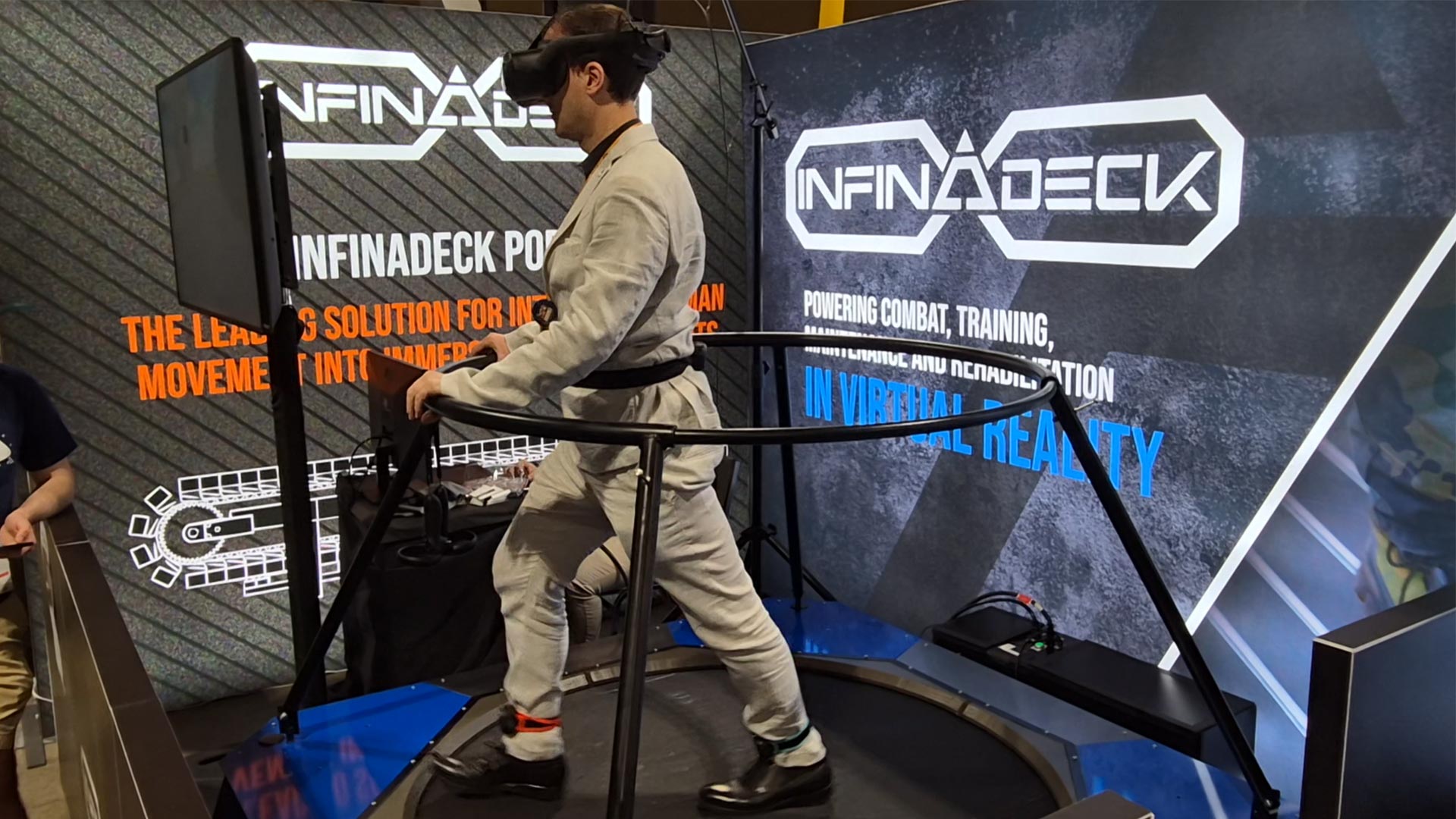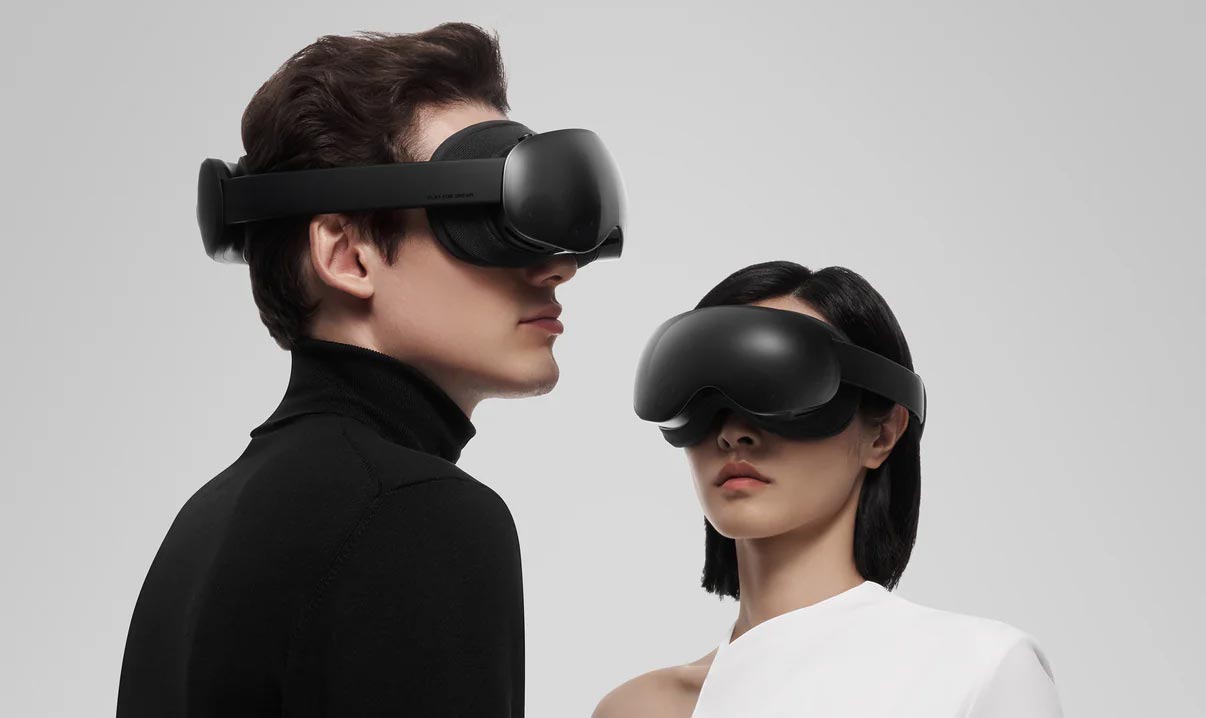Infinadeck first impressions: hands-on the treadmill from Ready Player One
After more than 5 years that I’ve been dreaming about it, I’ve finally been able to try the Infinadeck, the omnidirectional treadmill that seems taken from Ready Player One. Here are my first impressions from my short session with it at AWE!
[As usual, since I’ve just tested the device once for a few minutes, do not consider this article as a full-fledged review, but just as my first impressions on it.]
Infinadeck
Infinadeck is an omnidirectional treadmill for virtual reality. But while most VR treadmills are basically some platforms with a concave shape that let your feet slide while you walk, the Infinadeck always tries to use a more traditional form of treadmill. The idea is that while you walk on this planar surface, the surface moves in the direction that is opposite to yours, so that even if you walk in a certain direction, you physically stay in the same place, and do not go outside of the platform. Thanks to this, you can walk normally in real life and in the virtual world.
This is basically the same principle of fitness treadmills, and at its foundations, the Infinadeck reminds them. But its peculiarity is that it allows you to move in all directions around you, at 360°, so not only forward. In its initial iteration, this worked by being a “treadmill of treadmills”, that is, the main treadmill went backward to forward, while every slice of the treadmill could go left to right. Thanks to the combined movement of the two, it was possible to go in all directions. You can see it in action here:
As you can see, the walking detection was happening with Vive Trackers.
I have always been fascinated by the Infinadeck, because the other treadmills looked to me more like slip-mills, that do not let you do a fully natural walking movement, while I thought this had the potential of truly letting you walk normally in VR. But is this really the case? Discover it by reading my hands-on impressions.
Infinadeck design

When I reached the booth of the company at AWE, the first thing I noticed was that the design of the device had changed. There was still a platform with a safety ring, but it was smaller than I was expecting, and it was square instead of rectangular. Also, its floor didn’t look like a “treadmill of treadmills”.

Speaking with the team, I’ve discovered that this is the latest iteration of the device, that brings with it many improvements. The movement of the platform floor is more fluid, and doesn’t look anymore like two perpendicular movements in parallel, but just like a single movement in all directions. Also, since the platform is now square-ish and not rectangular anymore, I’ve been told that users tend to take equal steps in all directions, while before their brain tended to let them have longer steps in the (longer) longitudinal direction and shorter ones in the (shorter) transversal one.
The standard Vive tracker has also been substituted by three Vive Ultimate Trackers. The Ultimate tracker has the advantage that, since it performs inside-out tracking via onboard cameras, it keeps tracking no matter the leg occlusions. Plus, it performs much better in spaces like exhibitions, where IR light interferences tend to create big issues with base stations.

Initial setup
I guess the setup of the machine requires some time, but as a user, I had a very quick setup. I just put two straps with Vive Ultimate Trackers on my two ankles, and one around my waist, with the tracker lying on my back. And basically that’s it, from that moment the team could decide to turn on or off the walking detection, and I could use the device. I was surprised by the simplicity of use, which is much better, for instance, than wearing VR walking shoes.

After that, the team let me try the walking operation without the headset, so that I could get used to it. When they noticed I had gotten the grasp of it, they let me put the headset on and try to walk in a virtual reality space that was a plane hangar. I remember also FreeAim let me do my VR walking test in a plane hangar… I do not know why these people making VR walking devices have this fetish for planes, and I guess someone has to investigate.
First impressions while walking in Infinadeck

I’ll say this straightly: I’ve come out of the Infinadeck booth with mixed feelings.
I’ll start from the bad feelings, which came from the fact that I went there with too many expectations: after like 6 years dreaming of using the “Ready Player One treadmill”, I was expecting to try an ultra-realistic walking sensation and be full in awe (pun intended). Long story short, this did not happen.
If you think about that, even on fitness treadmills, you do not have the exact sensation of walking/running that you have while walking for real. So it was probably naive of me to expect something too realistic. And in fact, even when walking on Infinadeck, you don’t exactly feel like walking in real life. It’s hard to describe the sensation I had on my legs, but it was like I had to drag a bit my feet, and adapt my movement to the one of the treadmill. Sometimes I also skewed my body a bit to find more equilibrium when walking. Even the movement in the virtual world did not match the one that I was expecting, given the movement of my legs, but it was much slower.
I’ve also noticed that there is some lag in the walking detection, and the system, for instance, stops moving maybe 1-2 seconds after you stop walking. Also I was expecting the movement to start when I was doing the first step, but actually it is like the first step goes “unnoticed” and then the movement starts during the second one, which is a bit weird, because being the platform small, after the first step I was closer to the edge of the moving floor and so I was a bit “scared” of making the second step that would have taken me outside the platform. Actually, this never happened, because as soon as I lifted the second foot, the platform started moving, but psychologically, it was not a great thing for me.
Another thing I noticed is that while rotating to walk in all the directions, I could feel I was a bit dragged to the side during the transition movements.
Finally, I spent the whole time with my hands on the safety ring… I did not have enough time to learn how to properly walk there while feeling purely safe.
Anyway, apart from all these shortcomings, I can’t say that the experience was negative. It was interesting that I was able to walk in all directions in virtual reality by quasi-naturally walking with my feet. And I think the experience with Infinadeck is anyway a bit better than the ones I had with the standard slip-mills, because in this case, I had not this sensation I was sliding on ice, but the walking movement was more realistic. And it was also better than what I tried with motorized walking shoes (EktoVR, Freeaim), because I never felt really in danger: with the shoes, sometimes I had the sensation I could fall down, with Infinadeck, no. Even the moments I tried for a few seconds not to use the safety ring, I never felt in danger.
So, in general, it was a good test for me. I can say that it is a solution that is better than the others on the market. And it also has great potential. But it is far from perfect, yet.
Price and availability
Infinadeck is available by contacting the company directly through its website. I’ve been told the price privately, and while I can’t say how much it is, I can say that:
- The company also offers the possibility of “renting” the device for a subscription fee
- The price is suitable for medium-sized (but on the larger end of the “medium” category) and large companies. Especially ones with big budgets. I imagine that some sectors where this can be very useful are oil and gas training and the military.
And that’s it for today! As usual, for any questions or comments, feel free to use the comment sections below or on my social media channels! And stay tuned for my next article coming from the AWE showfloor…
Disclaimer: this blog contains advertisement and affiliate links to sustain itself. If you click on an affiliate link, I'll be very happy because I'll earn a small commission on your purchase. You can find my boring full disclosure here.



